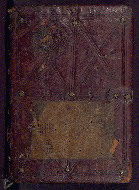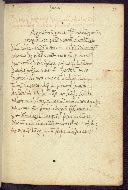Home > Digitized Walters Manuscripts
This document is a tranformation of a TEI P5 XML manuscript description incorporating images. If you have trouble reading special or non-Latin characters on this page, please make sure you have appropriate Unicode fonts installed and an up-to-date web browser.
Walters Ms. W.358, St. Basilius, De poetis legendis; Pseudo(?) Plutarch, De liberis educandis; Statius, Achilleid
Browse images (Browse images in a new window) | TEI in XML format
W.358
St. Basilius, De poetis legendis; Pseudo(?) Plutarch, De liberis educandis; Statius, Achilleid
Authority name: Basil, the Great, Saint, Bishop of Caesarea, approximately 329-379
As-written name: Magni basilius
Known as: St. Basilius
Authority name: Plutarch
As-written name: Plutarchus
Note: While "Plutarchus" is inscribed in the manuscript, it is likely that the text was in actuality composed by a scholar in his circle, thus later scholarship suggests "Pseudo-Plutarch" is more accurate.
Authority name: Statius, P. Papinius (Publius Papinius)
Written in Italy in the third quarter of the fifteenth century, this manuscript contains works by St. Basilius, Pseudo(?) Plutarch, and Statius. The first two texts are Greek treatises on education that were translated into Latin, bearing witness to the Italian humanist revival of, and interest in, the study of ancient Greek. The translators of those texts, Leonardo Bruni (d.1444) and Guarino Veronese (d.1460), both studied Greek under the tutelage of Byzantine scholar Manuel Chrysoloras (d.1415), who was one of the first to introduce Greek literature to Western Europe. The third text by Statius was included as part of a compendium of texts frequently used by students studying Latin beginning in the tenth century. During this same period, Statius was confused with the rhetorician Statius Ursulus of Toulouse, who is mentioned in Jerome’s translation of Eusebius’ chronicles as active in 56 CE. Statius' full Roman name was Publius Papinius Statius, however due to his conflation with the rhetorician in the tenth century, there are a number of manuscripts that begin Statius' name with “Sucurlus” instead of “Publius.” This can be found for instance in an Italian incunabula that is contemporary with W.358, and which is also found in the Walters’ collection (91.1119). This suggests that this error may have been a regional phenomenon in Italy.
Third quarter of the 15th century CE
Italy
Book
Philosophical
Historical
Literary -- Poetry
The primary language in this manuscript is Latin. The secondary language of this manuscript is Greek, Modern (1453-).
Paper
Text written on thick rag paper; pages that were originally flyleaves are laid paper, with watermark evident on fol. 1 (possibly scales?)
Foliation: 141
Modern pencil foliation, upper right corners, rectos
Formula: Quire 1: 2 (fols. 1-2); Quire 2-14: 10 (fols. 3-132); Quire 15: 8, with a ninth leaf hooked (fols. 133-141)
Catchwords: Occasional catchwords, as on fol. 52v
Signatures: Occasionally visible in lower right corners rectos, as on fols. 43-47
Comments: Quire 1 is bifolio, originally flyleaves
11.5 cm wide by 15.7 cm high
7.5 cm wide by 10.8 cm high
- Columns: 1
- Ruled lines: 15
- First line of text written above ruling
- Title: Collection of Ancient texts
- Authors: Basil, the Great, Saint, Bishop of Caesarea, approximately 329-379; Plutarch; Statius, P. Papinius (Publius Papinius)
- Hand note: Humanist script, three different hands, one for each text
- Decoration note: Space left for the initial at the beginning of the St. Basilius preface (fol. 3r) and text (fol. 5r), Plutarch preface (fol. 33r) and text (fol. 35r), and Statius text (fol. 73r); guide letters "m" and "q" written in or near the space for the initial text for both the preface and text of Plutarch respectively
- Title: Preface to St. Basilius, De poetis legendis
- Incipit: Ego tibi hunc librum Coluci ex media ut aiunt Grecia delegi
- Contents: A dedication of the text from Leonard Bruni, the first to translate this text of St. Basilius from Greek to Latin, to his mentor and teacher Coluccio Salutati; Salutati brought famed Byzantine scholar Manuel Chrysoloras to Florence in order that he teach Greek to a small group of Humanists, including Bruni, allowing them to read texts like Aristotle and Plato in the original language
- Title: St. Basilius, De poetis legendis
- Author: Basil, the Great, Saint, Bishop of Caesarea, approximately 329-379
- Incipit: Multa sunt filii quae hortantur me ad ea vobis consulenda
- Contents: This is a short treatise written by St. Basilius for his students, suggesting how how to properly read and learn from "pagan" literature and, in part, is a defense of such texts so long as their contents is morally upright
- Title: Preface to Plutarchus, De liberis educandis
- Incipit: Maiores nostros angele mi suavissime non ad mirari
- Contents: Dedicatory epistle of Italian humanist and classical scholar Guarino da Verona, the translator of De liberis educandis from Greek to Latin, to his student Angelo Corbinelli
- Title: Pseudo(?) Plutarchus, De liberis educandis
- Author: Plutarch
- Incipit: Quid nam est quod de ingenuorum educatione liberorum dicere
- Contents: This is a treatise on the importance of raising and educating children in the correct manner
- Title: Statius, Achilleid
- Author: Statius, P. Papinius (Publius Papinius)
- Rubric: Statii papinii surculi tholosensis achilleidos liber primus incipit
- Incipit: Magnanimum aeaciden formidatamque tonanti progeniem et patrio vetitam succedere caelo
- Contents: This is an unfinished epic poem that describes the early life of Trojan War hero Achilles
The binding is original.
Bound in Italy, third quarter of the fifteenth century; brown leather (calf?) over beech boards; blind tooled in a series of fillet lines; brass rosette-shaped studs at the junctures of some of the lines, at the border and in the center of each side, as well as on the edge of each compartment on the spine; evidence for a scarlet-stained single strap-clasp anchored to the front cover by two brass rosette-shaped studs; the trefoil-shaped brass catch plate still preserved on the back cover, previously decorated with a paschal lamb
Created third quarter of fifteenth century, Italy, for unknown patron
Thomas Payne and Henry Foss, Booksellers, London, ca. 1830; no. 611 in their catalog (pencil inscription "611 Payne" on fol. 1r)
Sir Thomas Phillipps, London, ca. 1830, by purchase from Payne and Foss (ink inscription "Phillipps MS 4542" on fol. 1r)
Maggs Bros., London, purchased from a sale of Phillipps' manuscripts on May 1, 1903 at Sotheby's London (then Sotheby's, Wilkinson and Hodge), lot 1094
Henry Walters, Baltimore, purchased from Maggs Bros. (?) before 1931
Walters Art Museum, 1931, by Henry Walters' bequest
De Ricci, Seymour. Census of Medieval and Renaissance Manuscripts in the United States and Canada. Vol. 1. New York: H. W. Wilson Company, 1935, p. 818, no. 373.
Berry, Edmund G. "The De Liberis Educandis of Pseudo-Plutarch." Harvard Studies in Classical Philology 63 (1958): 387-99.
Hays, Gregory. "The Pseudo-Fulgentian Super Thebaiden." In Vertis in Usum: Studies in Honor of Edward Courtney, edited by Cynthia Damon, John F. Miller, and K. Sara Myers. 200-218. Stuttgart: B.G. Teubner, 2012.
Catalogers: Berlin, Nicole; Herbert, Lynley; Walters Art Museum curatorial staff and researchers since 1934
Editor: Herbert, Lynley
Conservators: Polidori, Elisabetta; Quandt, Abigail
Contributors: Emery, Doug; Herbold, Rebekah; Tabritha, Ariel; Wiegand, Kimber
The Walters Art Museum
Licensed for use under Creative Commons Attribution-ShareAlike 3.0 Unported Access Rights, http://creativecommons.org/licenses/by-sa/3.0/legalcode. It is requested that copies of any published articles based on the information in this data set be sent to the curator of manuscripts, The Walters Art Museum, 600 North Charles Street, Baltimore MD 21201.

